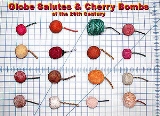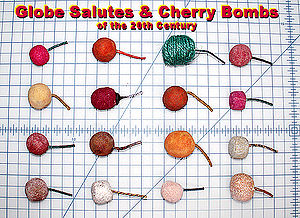
Cherry bomb
Encyclopedia
Cherry Bombs are approximately spherical shaped exploding fireworks, ranging in size from three-quarters-inch to one-and-one-half-inch (1.9 cm to 3.8 cm) in diameter. 
or, less commonly, black powder) which is generally encapsulated inside a paper cup, which is in turn most commonly surrounded by a layer (approx. one-quarter inch thick) of sawdust infused with a mild adhesive (usually sodium silicate). An ignition fuse is inserted into a hole drilled into the hardened sawdust sphere, all the way down to reach the explosive composition. The fuse extends outside the sphere approximately one to one and a half inches. Once the fuse is ignited, it takes about three to four and a half seconds to reach the explosive composition and initiate detonation of the firework.
The color of the salute's exterior varies, depending on the manufacturer and the time period during which the salute was produced. Early on, in the late-1920s and 1930s, Globe Salutes had fuses which were tan, red or striped and multi-colored, and their body color varied, ranging from brown and tan to silver and red, and some were even decorated with multi-colored confetti. However, by the 1940s the most common color of the spherical salutes being marketed was a deep pink to red, with a green fuse, which is when the name Cherry Salute and Cherry Bomb entered popular use.
Another source says they were originally charged with 5 to 10 times the amount of explosive composition a standard inch-and-a-half paper firecracker had. After the enactment of the Child Safety Act of 1966, all "consumer fireworks" (those available to individuals), such as silver tube salutes, cherry bombs and M-80s
, could not contain more than 50 milligrams of powder mixture, which typically amounted to less than 5% of their original amounts.
Original potency Cherry Bombs are now considered explosive devices in the United States
and possession, manufacture, or sale is illegal for individuals unless that individual has an explosives manufacturing license issued by the BATF/BATFE.
The Who
drummer Keith Moon
became infamous for playing practical jokes involving cherry bombs during the band's tours during the 1960's onward. It is estimated that over the years, he caused around US$500,000 of damage to hotel toilets, resulting in his lifetime ban from Holiday Inn
, Sheraton
and Hilton
Hotel chains, as well as the Waldorf Astoria. According to a biographer, he bought his first 500 cherry bombs in 1965. He later progressed to M-80
's and even dynamite
.

Composition
A typical cherry bomb contains a core of explosive composition (i.e., flash powderFlash powder
Flash powder is a pyrotechnic composition, a mixture of oxidizer and metallic fuel, which burns quickly and if confined produces a loud report. It is widely used in theatrical pyrotechnics and fireworks and was once used for flashes in photography.Different varieties of flash powder are made from...
or, less commonly, black powder) which is generally encapsulated inside a paper cup, which is in turn most commonly surrounded by a layer (approx. one-quarter inch thick) of sawdust infused with a mild adhesive (usually sodium silicate). An ignition fuse is inserted into a hole drilled into the hardened sawdust sphere, all the way down to reach the explosive composition. The fuse extends outside the sphere approximately one to one and a half inches. Once the fuse is ignited, it takes about three to four and a half seconds to reach the explosive composition and initiate detonation of the firework.
The color of the salute's exterior varies, depending on the manufacturer and the time period during which the salute was produced. Early on, in the late-1920s and 1930s, Globe Salutes had fuses which were tan, red or striped and multi-colored, and their body color varied, ranging from brown and tan to silver and red, and some were even decorated with multi-colored confetti. However, by the 1940s the most common color of the spherical salutes being marketed was a deep pink to red, with a green fuse, which is when the name Cherry Salute and Cherry Bomb entered popular use.
Canada
Cherry bombs are not authorized under the Explosives Act, thus making importation, possession, transportation, storage or manufacturing illegal in Canada.United States
These original spherical salutes were powerful enough to cause a legitimate safety concern. They were used in the civil war to either stun or hurt the enemy. They were banned in the USA in 1966, by the federal Child Safety Act of 1966. Historically, these Globe Salutes and Cherry Bombs were made in two halves. One half was filled with powder and the other half was glued in place on top of it, and the whole globe was covered with glue-coated string or sawdust. This left an air-gap which created a louder bang when the case ruptured. [source: 1965 Pyrotechnics Manufacturing Handbook)Another source says they were originally charged with 5 to 10 times the amount of explosive composition a standard inch-and-a-half paper firecracker had. After the enactment of the Child Safety Act of 1966, all "consumer fireworks" (those available to individuals), such as silver tube salutes, cherry bombs and M-80s
M-80 (explosive)
M-80s are a class of large firecrackers, sometimes called salutes. The Simulator, Artillery, M80, was originally made in the early 20th century by the U.S. Military to simulate explosives or artillery fire; Later, M-80s were manufactured as fireworks...
, could not contain more than 50 milligrams of powder mixture, which typically amounted to less than 5% of their original amounts.
Original potency Cherry Bombs are now considered explosive devices in the United States
United States
The United States of America is a federal constitutional republic comprising fifty states and a federal district...
and possession, manufacture, or sale is illegal for individuals unless that individual has an explosives manufacturing license issued by the BATF/BATFE.
The Who
The Who
The Who are an English rock band formed in 1964 by Roger Daltrey , Pete Townshend , John Entwistle and Keith Moon . They became known for energetic live performances which often included instrument destruction...
drummer Keith Moon
Keith Moon
Keith John Moon was an English musician, best known for being the drummer of the English rock group The Who. He gained acclaim for his exuberant and innovative drumming style, and notoriety for his eccentric and often self-destructive behaviour, earning him the nickname "Moon the Loon". Moon...
became infamous for playing practical jokes involving cherry bombs during the band's tours during the 1960's onward. It is estimated that over the years, he caused around US$500,000 of damage to hotel toilets, resulting in his lifetime ban from Holiday Inn
Holiday Inn
Holiday Inn is a brand of hotels, formally a economy motel chain, forming part of the British InterContinental Hotels Group . It is one of the world's largest hotel chains with 238,440 bedrooms and 1,301 hotels globally. There are currently 5 hotels in the pipeline...
, Sheraton
Sheraton
Sheraton may refer to:*Sheraton Hotels and Resorts, a hotel chain*Sheraton, County Durham, a village in County Durham, in England*Sheraton Centre, a mall complex located in the parish of Christ Church, Barbados....
and Hilton
Hilton
-Companies:* Hilton Worldwide, a global hospitality company based in the United States** Hilton Hotels, an international chain of hotels trademarked by Hilton Worldwide** Hilton Garden Inn, a chain of hotels trademarked by Hilton Worldwide...
Hotel chains, as well as the Waldorf Astoria. According to a biographer, he bought his first 500 cherry bombs in 1965. He later progressed to M-80
M-80 (explosive)
M-80s are a class of large firecrackers, sometimes called salutes. The Simulator, Artillery, M80, was originally made in the early 20th century by the U.S. Military to simulate explosives or artillery fire; Later, M-80s were manufactured as fireworks...
's and even dynamite
Dynamite
Dynamite is an explosive material based on nitroglycerin, initially using diatomaceous earth , or another absorbent substance such as powdered shells, clay, sawdust, or wood pulp. Dynamites using organic materials such as sawdust are less stable and such use has been generally discontinued...
.
See also
- Salute (pyrotechnics)Salute (pyrotechnics)In pyrotechnics a salute is a device primarily designed to make a loud report , and may or may not have a visual effect. Most salutes will also have a very bright flash and are made from many different formulas depending on manufacturer and desired effect. They may have aluminum, antimony,...
- M-80M-80 (explosive)M-80s are a class of large firecrackers, sometimes called salutes. The Simulator, Artillery, M80, was originally made in the early 20th century by the U.S. Military to simulate explosives or artillery fire; Later, M-80s were manufactured as fireworks...
- GlasspackGlasspackA glasspack, sometimes called Cherrybomb is a type of automobile muffler in which the exhaust gas passes straight through the center of the muffler. Packed fibreglass surrounds the exhaust channel and absorbs some of the high-frequency sound.All mufflers impede the flow of exhaust gas and create...
- an automotive mufflerMufflerA muffler is a device for reducing the amount of noise emitted by the exhaust of an internal combustion engine. A US Patent for an Exhaust muffler for engines was granted to Milton and Marshall Reeves in 1897....
, often known by its genericized trademarkGenericized trademarkA genericized trademark is a trademark or brand name that has become the colloquial or generic description for, or synonymous with, a general class of product or service, rather than as an indicator of source or affiliation as intended by the trademark's holder...
name, Cherrybomb.

